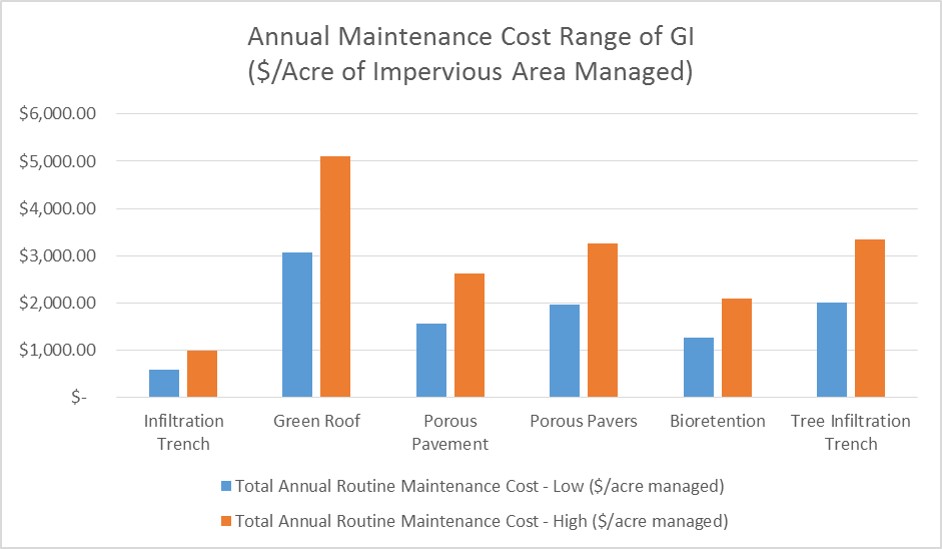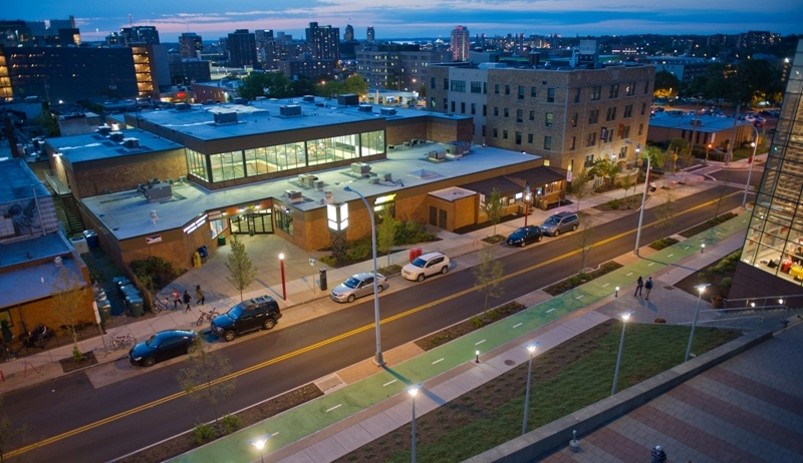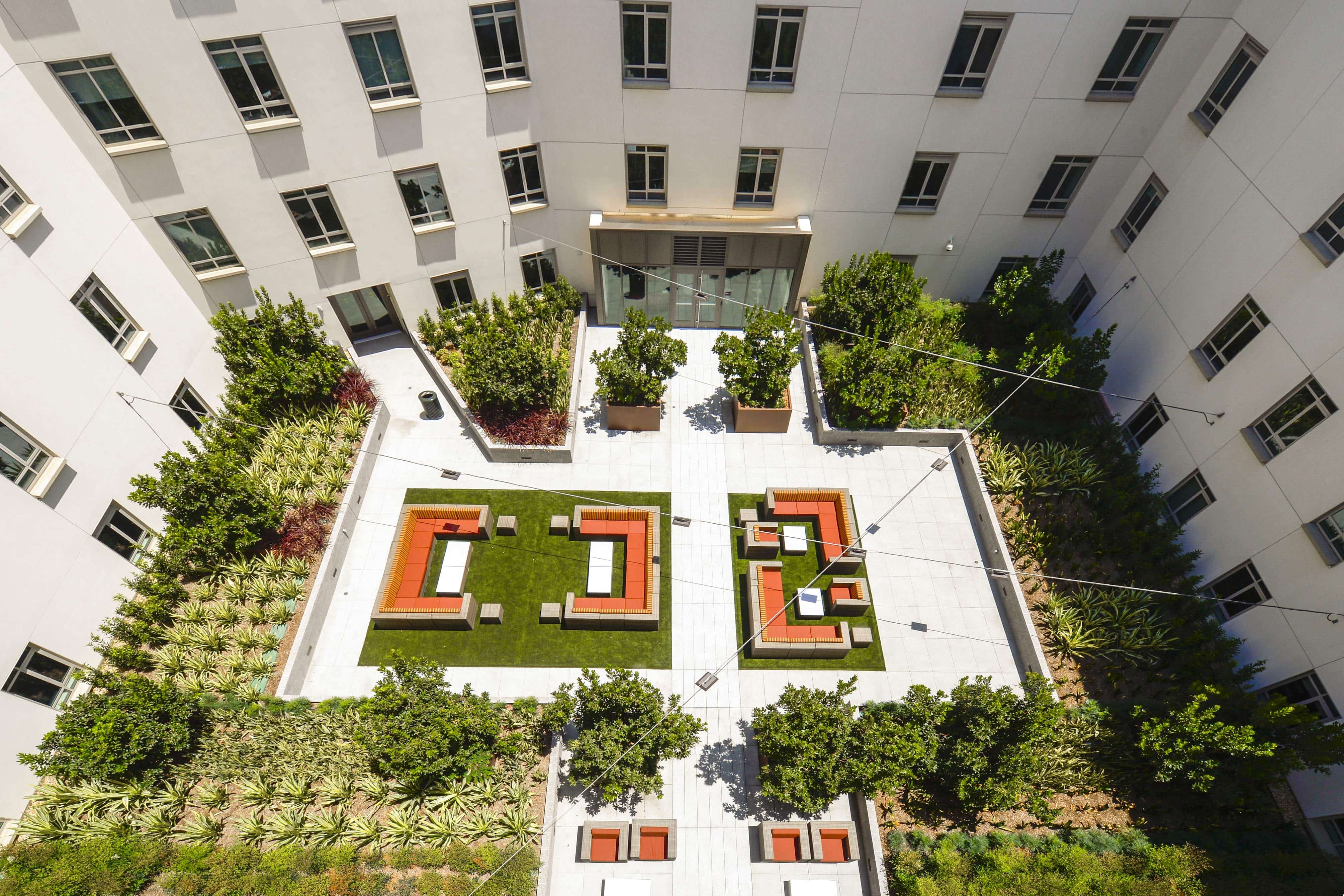

Data from hundreds of built projects across the U.S. — such as Brandon Park in Lancaster, Pa. pictured here — provide insights into how communities can reduce green infrastructure costs and plan more effectively for long-term operations and maintenance. Image by CH2M
In the U.S., funding and valuation of green infrastructure is one of the most significant barriers to implementation of this stormwater management approach. However, there are ways to reduce capital costs and plan more effectively for long-term operations and maintenance (O&M). In a study of hundreds of built projects from across the U.S., CH2M water resources consultants Andrew Potts, Brian Marengo, and Dan Wible examined proven strategies for reducing green infrastructure costs.
As presented at WEFTEC 2015 in Chicago, they dissected green infrastructure program data to generate new insights on significant factors that influence cost. These insights can help stormwater program managers not only save money but also better evaluate the cost-effectiveness of green infrastructure approaches. Reliable costing information helps communities adequately plan for green infrastructure implementation and long-term O&M. As green infrastructure programs mature, there is more data available about the life-cycle costs of this approach. Looking at this data in new ways can reveal the real costs of green infrastructure.
.
Four Cost Reduction Strategies for Green Infrastructure
Green infrastructure encompasses many practices that retain runoff onsite, from bioretention and green roofs to porous pavements. Many such practices rely on the natural processes of infiltration and evapotranspiration and use soils as a filter to treat and manage stormwater. Green infrastructure type, performance requirements, and sizing are important and often-analyzed cost considerations. Communities frequently examine such cost-efficiency metrics as the cost per square meter of green infrastructure, the cost per liter of storage provided, or the cost per gram of pollutant removed.
However, many local and site specific factors ― such as land value, space limitations, existing utilities, and environmental conditions (including slope and soils) ― can influence costs heavily and make them more variable.
“Green infrastructure costs can vary widely,” said Potts, a senior watershed services technologist at CH2M. “You cannot simply assume a certain practice will cost $10 per square foot.”
According to Potts, location in the urban environment and aesthetic needs are significant determining factors for capital construction costs. Highly manicured green infrastructure — often expected in high-profile locations — requires more intensive design, installation, and maintenance than systems created primarily for function.
“A rain garden in front of city hall will cost more than one off in a highway median,” Potts said. “The effect of project setting on O&M costs is just as important, if not more so, than for construction.”
Other site-specific factors affect O&M costs as well. However, these costs can be minimized by addressing O&M during the planning and design of green infrastructure systems. For example, maintenance costs for porous pavements can be reduced by not placing them in areas with high leaf litter or sediment.
Despite the variability of green infrastructure costs, Potts and his colleagues have identified four proven strategies for reducing costs and making the business case for green infrastructure.
.
Integrate with Planned Projects

Stemming from an award-winning partnership between Onondaga County, Syracuse University, and the City of Syracuse, the Connective Corridor incorporates several green infrastructure practices into a major streetscape project. The project improves the connection between University Hill and downtown Syracuse. This integrated project has been one of the largest and most cost-effective in the Save the Rain program to date. Image by Syracuse University (top) │Images by CH2M (bottom)
Retrofitting existing sites with green infrastructure typically is more expensive than integrating the systems during new construction. However, according to Potts and his colleagues, communities can realize cost savings of 30% to 60% by integrating green projects with planned infrastructure improvements, such as road reconstruction, utility restoration, or roof replacements.
“Projects focused solely on managing stormwater and implementing green infrastructure will cost more than those integrated with road work or other facility improvements,” Potts said. “Integrating is an enabler to reduce costs.”
Save the Rain, a program by Onondaga County, New York, is intended to improve the water quality of Onondaga Lake by reducing combined sewer overflows using a mixture of green and grey techniques. Rather than analyze the cost of the county’s green infrastructure by type, Potts and colleagues assessed the data by nine green infrastructure implementation programs, such as green streets, vacant lot greening, and green schools.
The team found that the most cost effective projects were those integrated with the city’s annual street construction work at $320,000 per impervious hectare ($129,000 per impervious acre) managed. Green schools, some of which were integrated with school renovation projects, were the second most cost effective of Onondaga County’s green infrastructure programs.
By this definition of integration, the real costs of green infrastructure are only those beyond the cost of conventional planned improvements.
To reduce costs, Potts advises communities to think programmatically rather than on an individual project basis. “Consider how you can organize green infrastructure into repeatable program types that have similar contracting and implementation mechanisms,” Potts said. “Leverage public investments to achieve multiple objectives by integrating with existing public works projects, such as water, sewer, and street improvements.”

Brandon Park in Lancaster, Pa. before (top) and after (bottom) the installation of green infrastructure, including bioretention and porous pavement. Green features were integrated cost-effectively with other park improvements such as new play equipment and better access for those with disabilities. Images by CH2M
.
Seek Economies of Scale
“Economy-of-scale is another factor that in general provides good trends in downward unit costs,” Potts said. This includes practices that hold a greater volume, aggregated projects, or regional- and neighborhood-scale projects — for instance five blocks of green streets compared to only one block.
Illustrating the benefits of economy of scale, an analysis of some infiltration trenches with vegetated cover in Philadelphia reveals that doubling the storage capacity of these practices would increase construction costs by only 14% to 27%. Because some storage will go unused during smaller storms, increasing capacity can result in diminishing returns. However increased capacity can provide other benefits, such as flood reduction and climate change resiliency. Therefore, sizing criteria should be carefully considered based on an individual community’s goals.
Save It! Lancaster is a program by the City of Lancaster, Pa., to prevent 2.8 million m3 (750 million gal) of water from entering its combined sewer system annually. In analyzing 24 green infrastructure projects that are part Lancaster’s efforts to reduce combined sewer overflows, Potts and colleagues found that larger projects generally resulted in lower unit costs for green alleys, public parking lots, and projects constructed on private property as part of public-private-partnerships.
However, other factors can be more important or override decreases in costs due to economy of scale. For instance, in Lancaster, integration with other planned improvements affected green street costs more than economy of scale.
In examining Onondaga County’s Save the Rain programs, the consultants found that projects capturing runoff from a larger area were more cost-effective on average with the exception of county-owned facilities. These facilities included some projects at local libraries and the Rosamond Gifford Zoo. In these cases, site specific conditions such as access and aesthetic goals affected project costs more than size.

Cost data from 127 green stormwater infrastructure projects in Onondaga County, N.Y., demonstrate the influence of both scale and implementation program. Graph by CH2M
.
Use Incentive Programs

The Plum and Walnut intersection before (top) and after (bottom) the City of Lancaster, Pa., improved traffic and pedestrian safety, implemented significant green infrastructure, and enhanced a local business through this integrated, public-private partnership project. Images by CH2M
Programs that incentivize businesses and residents to install green infrastructure on private property include grants, rebates, and credit programs. By encouraging private sector participation, such programs can help communities install retrofits more cost efficiently and meet stormwater goals more quickly.
In 2010, Onondaga County became one of the first communities to share the costs of widespread green infrastructure implementation with the private sector, according to a business case evaluation. The county’s Green Infrastructure Fund is available in specific combined sewersheds. Since its inception, the program has provided more than $7 million in funding on projects that have captured more than 110,000 m3 (29 million gal) across the City of Syracuse.
As of July 2015, this grant program has led to the development of 76 projects. Construction on the green infrastructure components of these projects cost $8.3 million as part of more than $18 million in overall redevelopment. Average constructed costs of $462,000 per hectare of impervious area managed ($187,000 per acre) are competitive with other cost-effective implementation programs.
Additionally, in agreements with private property owners, maintenance is often the responsibility of the property owner. Decreasing the burden of construction and O&M costs on public entities underscores the benefit of incentive programs.
.
Consider Maintenance in a New Ways
Directly comparing the maintenance costs of stormwater infrastructure by unit area of green infrastructure, vegetated systems generally are more expensive to maintain than subsurface and non-vegetated systems. However, taking into account the surrounding impervious area treated by green infrastructure reveals new insights. Analyzing the annual estimated maintenance costs for green infrastructure practices by acre treated, Potts and colleagues found that some technologies become more cost-effective to maintain.
For instance, CH2M estimated that, per square foot, bioretention is one of its most expensive systems to maintain. However, by taking into account the surrounding impervious area treated, bioretention actually becomes one of the most cost-effective systems — on par with most subsurface systems. In contrast, green roofs, which typically manage only direct rainfall or runoff from adjacent roof areas, are typically the most expensive to maintain.
These insights can help communities select the systems that capture the most runoff with the lowest long-term O&M costs. “That being said, different green stormwater infrastructure practices have specific applications and different benefits that can also factor significantly into the selection process,” Potts said.


Typical annual maintenance cost-ranges for green stormwater infrastructure based on cost per square foot of green infrastructure (top) compared with maintenance costs based on square foot of impervious area managed (bottom). Graphs by CH2M
.
To unveil the true costs of green infrastructure, it also is important to understand how maintenance of such practices builds on current operations within the conventional urban environment. For instance, modern vacuum trucks can accomplish both porous pavement vacuuming and traditional street sweeping. And in some cases, particularly where a more natural aesthetic is used, vegetated systems may require even less maintenance than traditional landscapes, such as turf grasses that require frequent mowing.
Similar to reducing construction costs by combining green infrastructure with other planned projects, integrating with other planned services also can reduce O&M costs, Potts said.
Economy of scale plays a role as well. Maintenance costs can be reduced when the number of practices reaches critical mass. For instance, when there are enough practices in the ground to have a dedicated service crew or enough competition to achieve good pricing. “The cost of maintenance for a standalone practice may not be representative of a fully built out program,” Potts said.
***
Invariably, decisions about stormwater management infrastructure often are financial. A strong business case is needed to define appropriate levels of green infrastructure controls relative to other alternatives, writes Potts and coauthors Marengo and Wible. To do so, it is important to examine the real costs of green infrastructure. Conversely, an understanding of the full benefits is equally important, Potts advises. Beyond water quality improvements, green infrastructure can provide communities with a range of benefits, from habitat creation to improved health and wellness.
















Thanks for this. What I really want is a copy of the full CH2M/Potts, Marengo report. Where can I get that?
Thanks.
Hi Mateo, you can find the full paper and many others in the WEFTEC 2015 proceedings in the WEF store at https://www.e-wef.org/Store/ProductDetails.aspx?productId=47775161
I found the article very informational and I agree with almost everything. However, I’m not convinced treating storm water runoff to make it more “chemically clean” will actually meet the goals of the Clean Water Act (fishable and swimmable) in all cases. Our studies indicate that in many instances, but not in all, habitat degradation is the main stressor that causes the impairment. Furthermore, our habitat restoration projects resulted in substantial increases in IBI (fish and macroinvertebrates) scores. That didn’t hold true with the BMPs that merely treated storm water runoff. Of course there are situations where the critical parameter is a pollutant that is causing the impairment and that needs to be addressed as well. With extremely limited resources I think we also need to be very careful in selecting projects that will actually meet the goals of the CWA, rather than just assuming if were cleaning the storm water we are making a difference.
Great work, we are happy to have C2HM working in Radnor! The before and after pictures of the intersection of Plum & Walnut are very compelling!
Great article and study – thanks! Another area not discussed is the integration of urban forestry with stormwater. If trees are planted and designed not just for aethetics, but also for stormwater treatment and use of rain as a resource, multiple benefits can be realized. Street tree plantings can be designed and constructed to treat run-off from adjacent roadways and use the rain for irrigation instead of potable water. There are some design challenges with this idea and it costs an order of magnitude more per tree, but the benefits of integrating these two practices can be significant and will outweigh the costs – especially over time as the trees grow to full size.